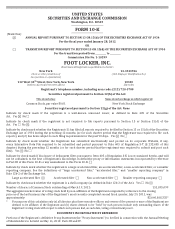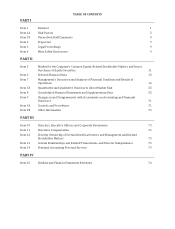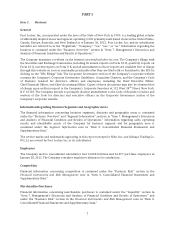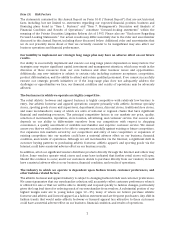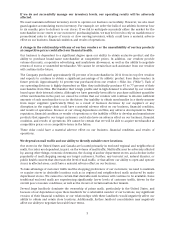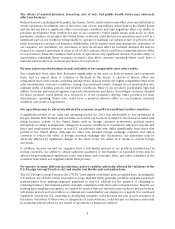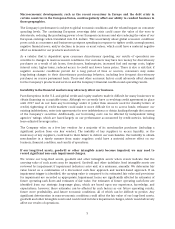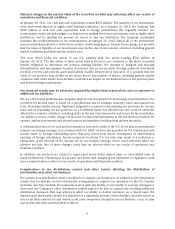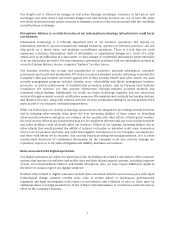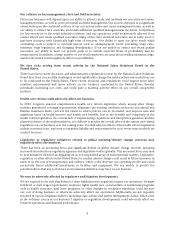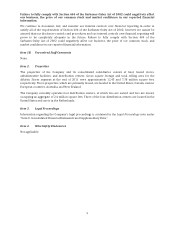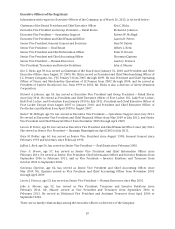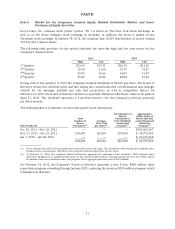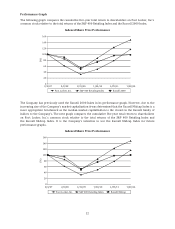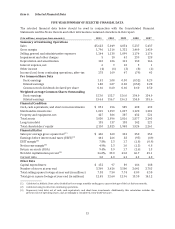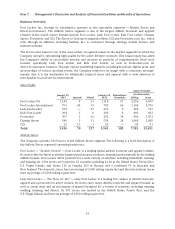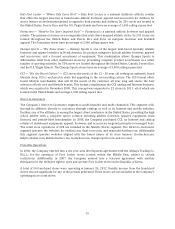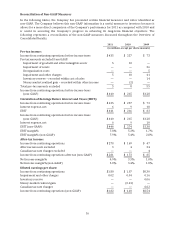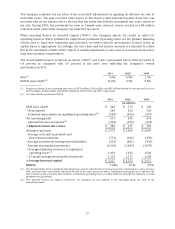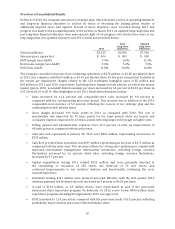Foot Locker 2011 Annual Report Download - page 28
Download and view the complete annual report
Please find page 28 of the 2011 Foot Locker annual report below. You can navigate through the pages in the report by either clicking on the pages listed below, or by using the keyword search tool below to find specific information within the annual report.Our reliance on key management, store and field associates.
Future performance will depend upon our ability to attract, retain, and motivate our executive and senior
management team, as well as store personnel and field management. Our success depends to a significant
extent both upon the continued services of our current executive and senior management team, as well as
our ability to attract, hire, motivate, and retain additional qualified management in the future. Competition
for key executives in the retail industry is intense, and our operations could be adversely affected if we
cannot attract and retain qualified associates. Many of the store and field associates are in entry level or
part-time positions with historically high rates of turnover. Our ability to meet our labor needs while
controlling costs is subject to external factors such as unemployment levels, prevailing wage rates,
minimum wage legislation, and changing demographics. If we are unable to attract and retain quality
associates, our ability to meet our growth goals or to sustain expected levels of profitability may be
compromised. In addition, a large number of our retail employees are paid the prevailing minimum wage,
which if increased would negatively affect our profitability.
We face risks arising from recent activity by the National Labor Relations Board in the
United States.
There have been recent decisions, and administrative regulations issued, by the National Labor Relations
Board that, if not successfully challenged, would significantly change the nature of how union elections are
to be conducted in the United States. These recent decisions and regulations could impose more labor
relations requirements and union activity on our business conducted in the United States, thereby
potentially increasing our costs, and could have a material adverse effect on our overall competitive
position.
Health care reform could adversely affect our business.
In 2010, Congress enacted comprehensive health care reform legislation which, among other things,
includes guaranteed coverage requirements, eliminates pre-existing condition exclusions and annual and
lifetime maximum limits, restricts the extent to which policies can be rescinded, and imposes new and
significant taxes on health insurers and health care benefits. Due to the breadth and complexity of the
health reform legislation, the current lack of implementing regulations and interpretive guidance, and the
phased-in nature of the implementation, it is difficult to predict the overall effect of the statute and related
regulations on our business over the coming years. Possible adverse effects of the health reform legislation
include increased costs, exposure to expanded liability and requirements for us to revise ways in which we
conduct business.
Legislative or regulatory initiatives related to global warming/climate change concerns may
negatively affect our business.
There has been an increasing focus and significant debate on global climate change recently, including
increased attention from regulatory agencies and legislative bodies globally. This increased focus may lead
to new initiatives directed at regulating an as-yet unspecified array of environmental matters. Legislative,
regulatory or other efforts in the United States to combat climate change could result in future increases in
taxes or in the cost of transportation and utilities, which could decrease our operating profits and could
necessitate future additional investments in facilities and equipment. We are unable to predict the
potential effects that any such future environmental initiatives may have on our business.
We may be adversely affected by regulatory and litigation developments.
We are exposed to the risk that federal or state legislation may negatively impact our operations. Changes
in federal or state wage requirements, employee rights, health care, social welfare or entitlement programs
such as health insurance, paid leave programs, or other changes in workplace regulation could increase
our cost of doing business or otherwise adversely affect our operations. Additionally, we are regularly
involved in various litigation matters, including class actions and patent infringement claims, which arise
in the ordinary course of our business. Litigation or regulatory developments could adversely affect our
business operations and financial performance.
8



